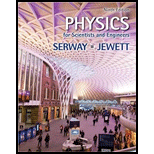
Concept explainers
(a) Use the data in Problem 3 to construct a smooth graph of position versus time. (b) By constructing tangents to the x(t) curve, find the instantaneous velocity of the car at several instants. (c) Plot the instantaneous velocity versus time and, from this information, determine the average acceleration of the car. (d) What was the initial velocity of the car?
(a)
The graph of position versus time.
Answer to Problem 2.18P
Therefore, the smooth graph of position versus time is shown in Figure I.
Explanation of Solution
The following table contains the data of position of the car at various time instants.
Draw the graph of position versus time for the derby car.
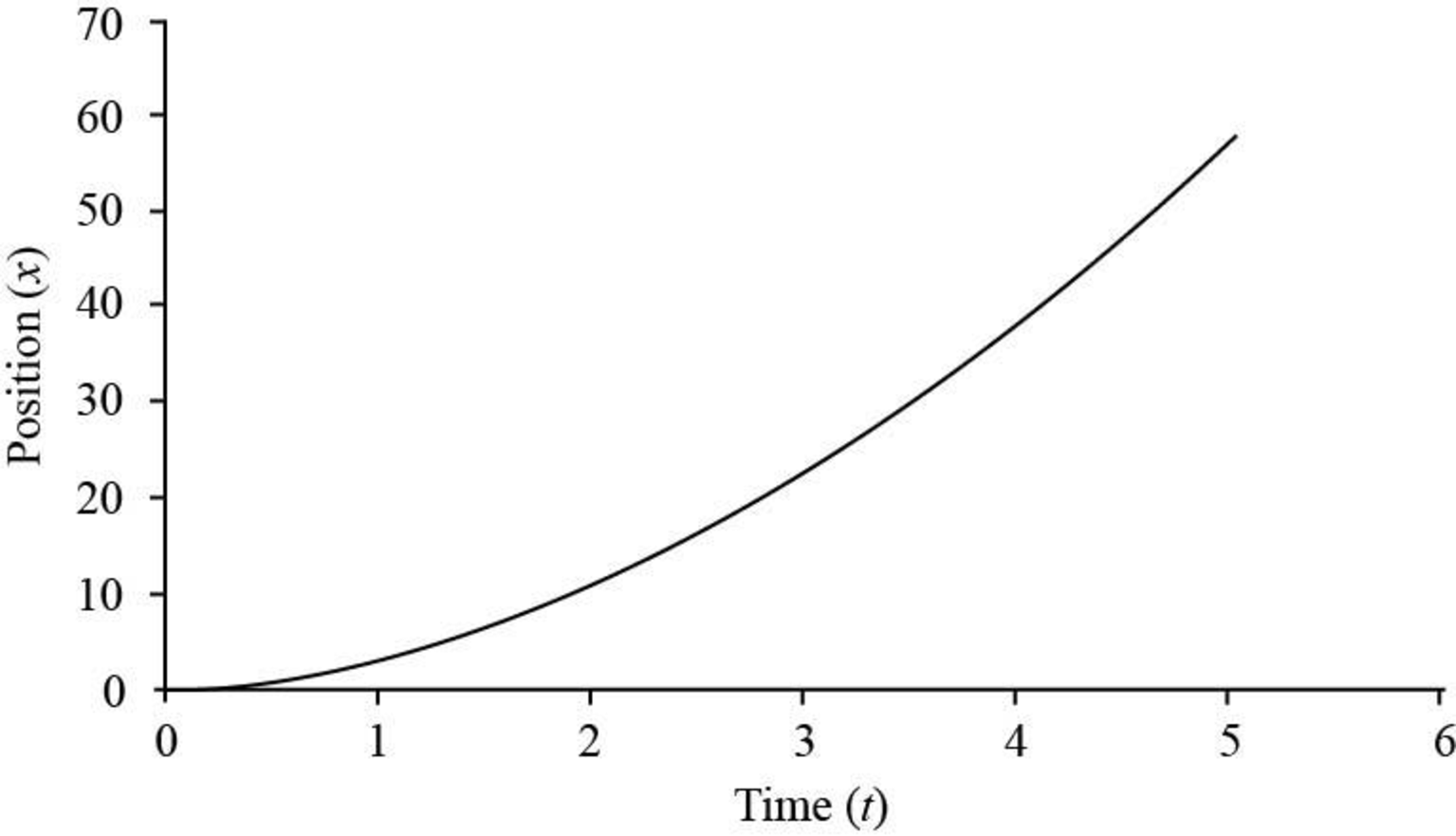
Figure I
In the shown graph, the position of the car at various time instants is plotted in the vertical axis against the time along horizontal direction.
Conclusion:
Therefore, the smooth graph of position versus time is shown in Figure I.
(b)
The instantaneous velocity of the car at various time instants.
Answer to Problem 2.18P
The instantaneous velocity of the car at
Explanation of Solution
The following table contains the data of position of the car at various time instants.
The instantaneous velocity is the slope of the tangent of the position versus time graph at an instant.
Formula to calculate the slope of the tangent is,
Here,
Draw the tangent line at the time instant of

Figure II
Substitute
Therefore, the instantaneous velocity of the car at
Draw the tangent line at the time instant of
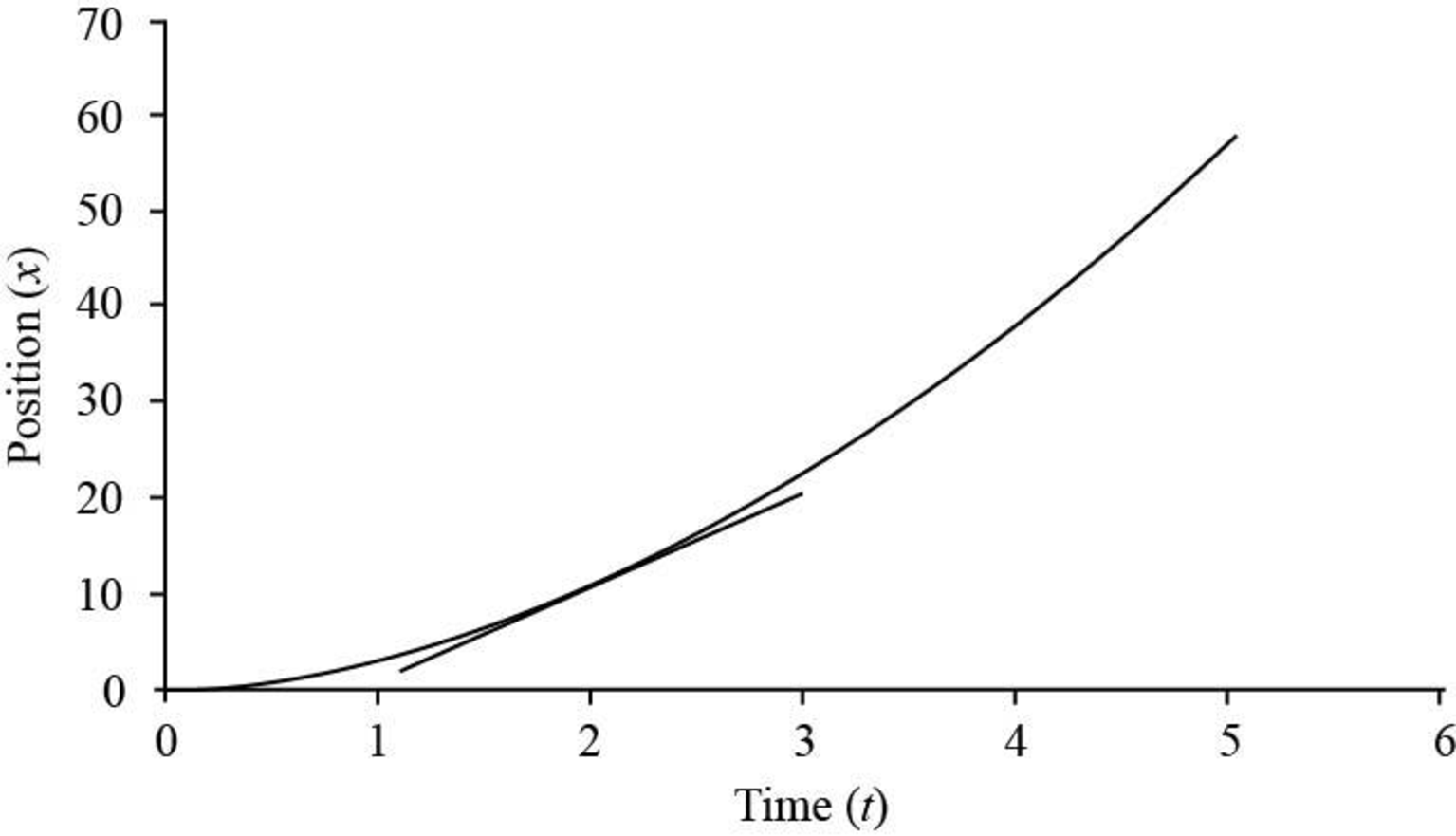
Figure III
Substitute
Therefore, the instantaneous velocity of the car at
Draw the tangent line at the time instant of
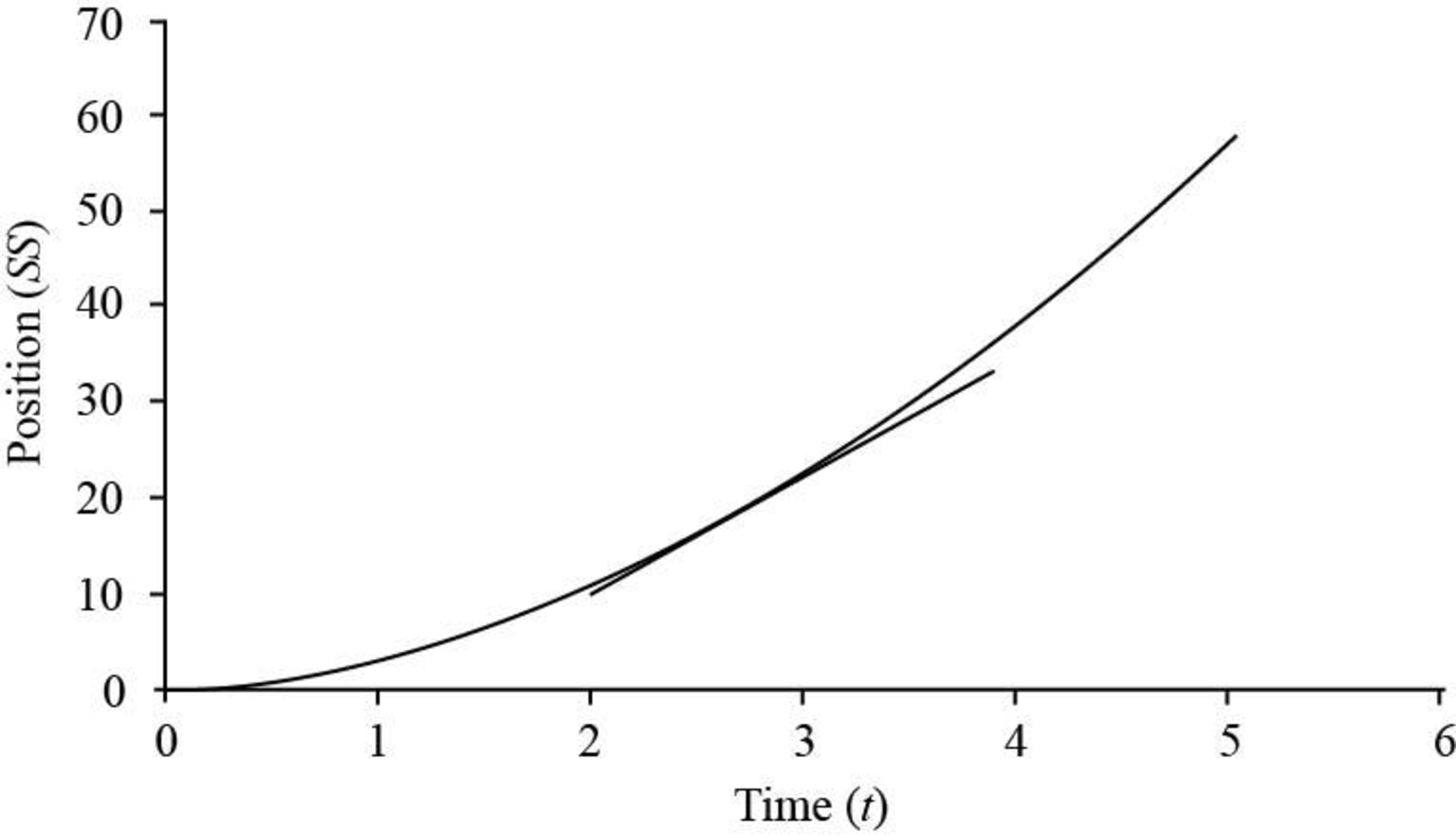
Figure IV
Substitute
Therefore, the instantaneous velocity of the car at
Draw the tangent line at the time instant of
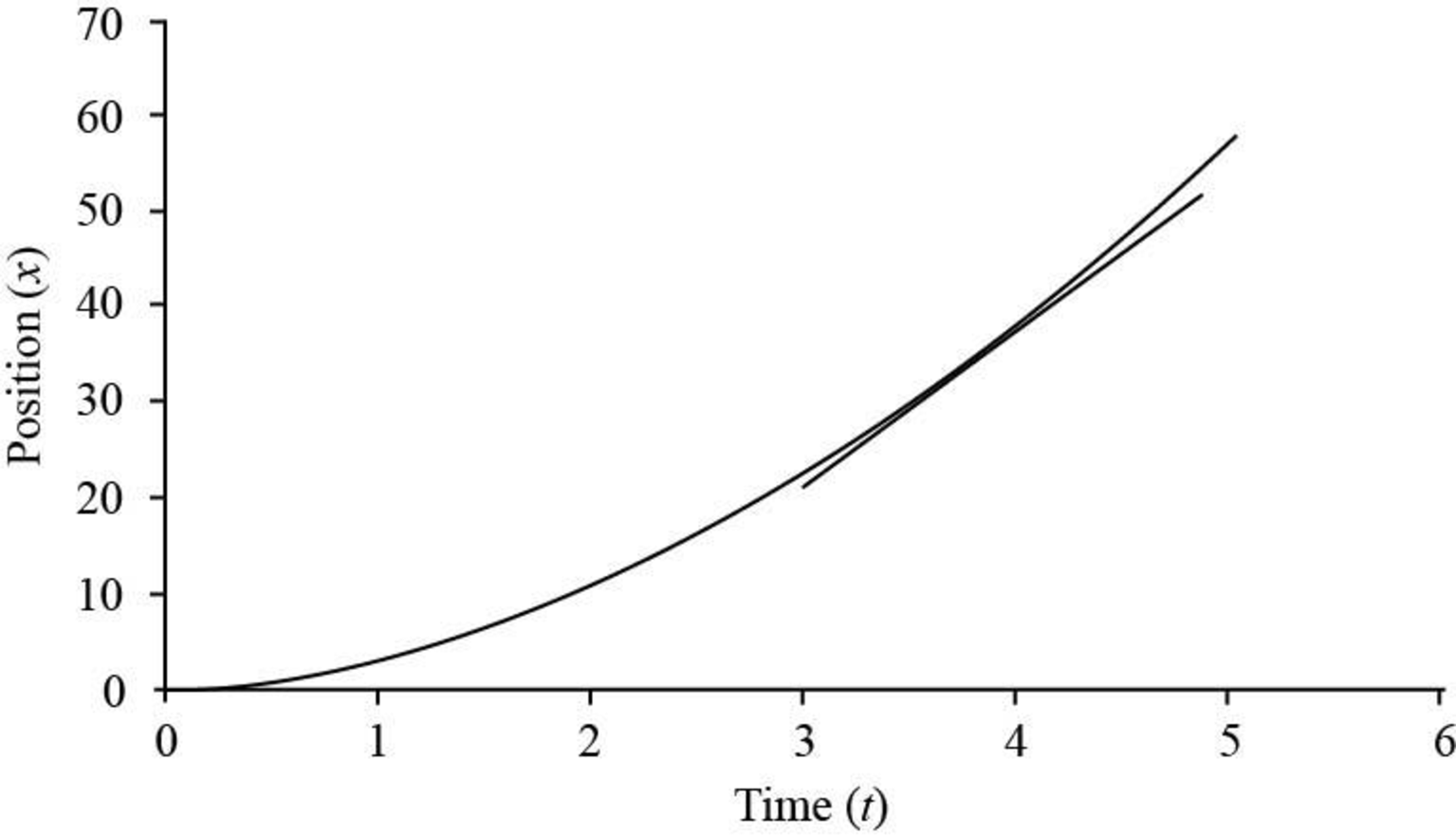
Figure V
Substitute
Therefore, the instantaneous velocity of the car at
Draw the tangent line at the time instant of
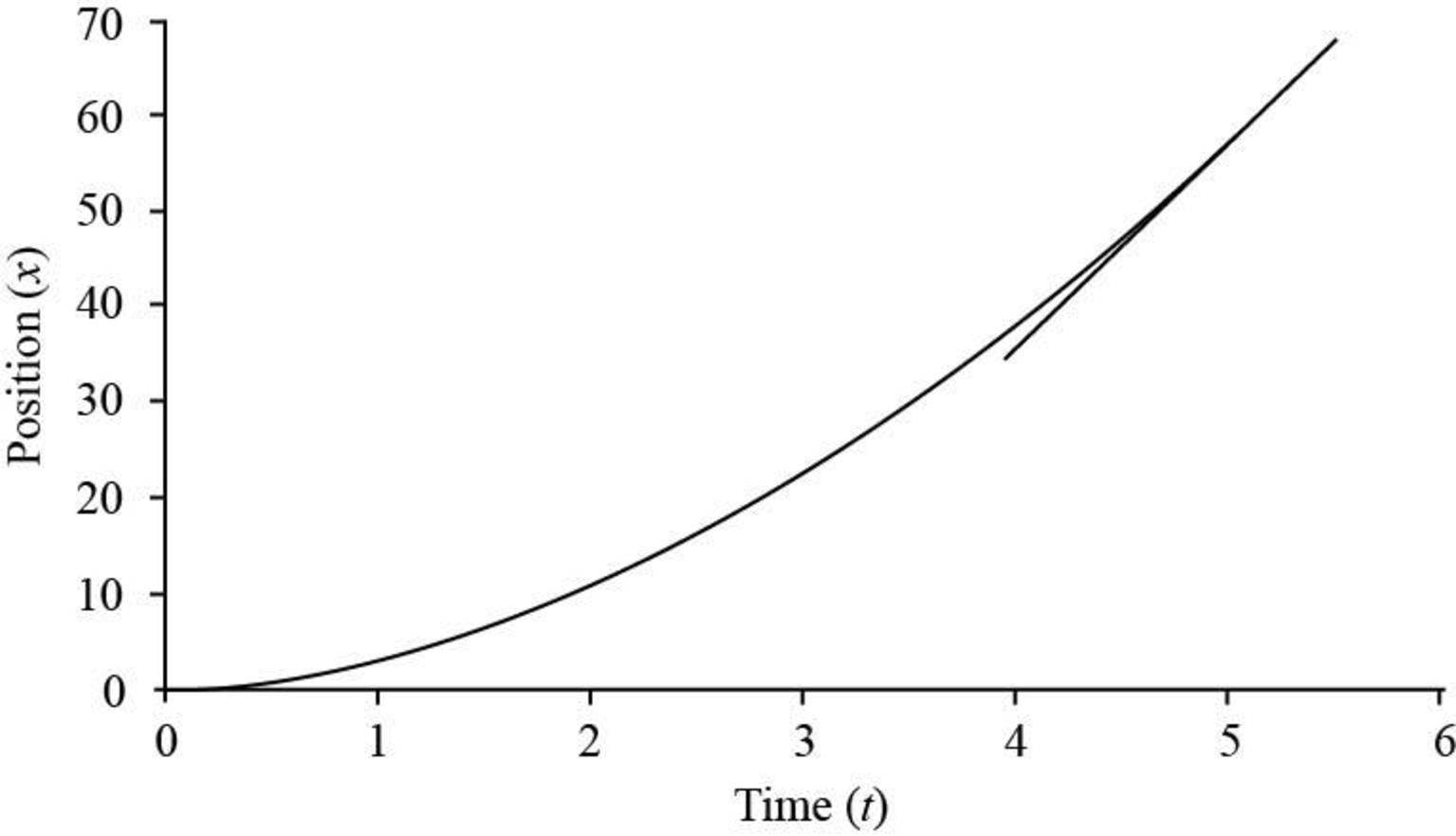
Figure VI
Substitute
Conclusion:
Therefore, the instantaneous velocity of the car at
(c)
The average acceleration of the car.
Answer to Problem 2.18P
The average acceleration of the car is
Explanation of Solution
The following table contains the instantaneous velocity of the car at various times instant.
The graph of instantaneous velocity versus time for the derby car is shown below.
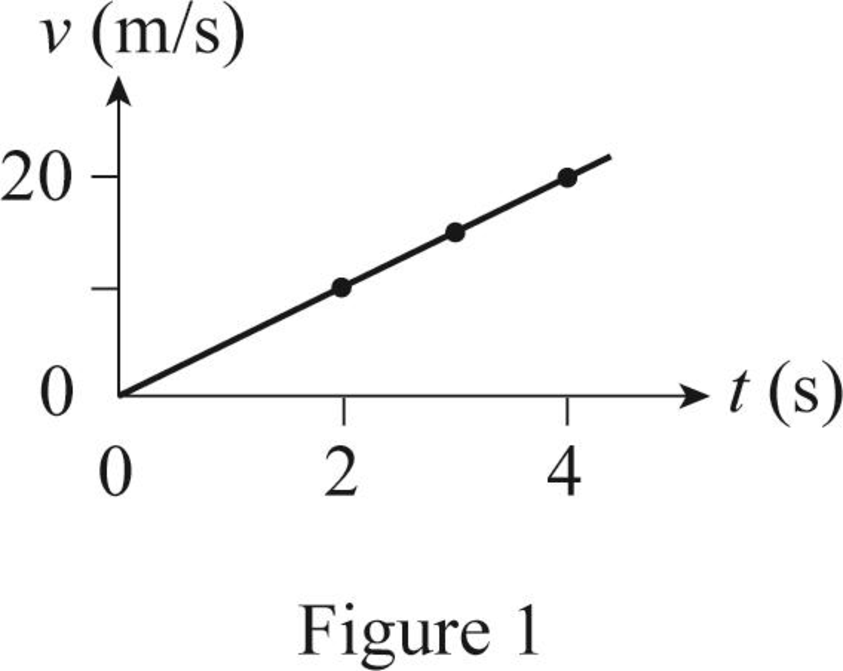
Figure VII
The figure VII shows that velocity of the car increases linearly, it means the acceleration of the car is constant throughout the motion.
Thus, the slope of this graph gives the average acceleration of the car.
Formula to calculate the slope of versus time graph is,
Here,
Substitute
From the graph, the slope of the graph is
Conclusion:
Therefore, the average acceleration of the car is
(d)
The initial velocity of the car.
Answer to Problem 2.18P
The initial velocity of the car is zero.
Explanation of Solution
The equation for the velocity of the car obtained from the graph is,
The first equation of motion gives the velocity of an object at any instant.
Here,
Compare equation (I) and (II).
Thus, the initial velocity of the car is zero.
Conclusion:
Therefore, the initial velocity of the car is zero.
Want to see more full solutions like this?
Chapter 2 Solutions
PHYSICS 1250 PACKAGE >CI<
Additional Science Textbook Solutions
College Physics: A Strategic Approach (3rd Edition)
Cosmic Perspective Fundamentals
Essentials of Human Anatomy & Physiology (12th Edition)
Fundamentals of Anatomy & Physiology (11th Edition)
- please answer this asap!!!!arrow_forwardRT = 4.7E-30 18V IT = 2.3E-3A+ 12 38Ω ли 56Ω ли r5 27Ω ли r3 28Ω r4 > 75Ω r6 600 0.343V 75.8A Now figure out how much current in going through the r4 resistor. |4 = unit And then use that current to find the voltage drop across the r resistor. V4 = unitarrow_forward7 Find the volume inside the cone z² = x²+y², above the (x, y) plane, and between the spheres x²+y²+z² = 1 and x² + y²+z² = 4. Hint: use spherical polar coordinates.arrow_forward
- ганм Two long, straight wires are oriented perpendicular to the page, as shown in the figure(Figure 1). The current in one wire is I₁ = 3.0 A, pointing into the page, and the current in the other wire is 12 4.0 A, pointing out of the page. = Find the magnitude and direction of the net magnetic field at point P. Express your answer using two significant figures. VO ΜΕ ΑΣΦ ? Figure P 5.0 cm 5.0 cm ₁ = 3.0 A 12 = 4.0 A B: μΤ You have already submitted this answer. Enter a new answer. No credit lost. Try again. Submit Previous Answers Request Answer 1 of 1 Part B X Express your answer using two significant figures. ΜΕ ΑΣΦ 0 = 0 ? below the dashed line to the right P You have already submitted this answer. Enter a new answer. No credit lost. Try again.arrow_forwardAn infinitely long conducting cylindrical rod with a positive charge λ per unit length is surrounded by a conducting cylindrical shell (which is also infinitely long) with a charge per unit length of −2λ and radius r1, as shown in the figure. What is σinner, the surface charge density (charge per unit area) on the inner surface of the conducting shell? What is σouter, the surface charge density on the outside of the conducting shell? (Recall from the problem statement that the conducting shell has a total charge per unit length given by −2λ.)arrow_forwardA small conducting spherical shell with inner radius aa and outer radius b is concentric with a larger conducting spherical shell with inner radius c and outer radius d (Figure 1). The inner shell has total charge +2q, and the outer shell has charge −2q. What's the total charge on the inner surface of the small shell? What's the total charge on the outer surface of the small shell? What's the total charge on the inner surface of the large shell? What's the total charge on the outer surface of the large shell?arrow_forward
- A small conducting spherical shell with inner radius a and outer radius b is concentric with a larger conducting spherical shell with inner radius cc and outer radius d (Figure 1). The inner shell has total charge +2q, and the outer shell has charge −2q. What is the direction of the electric field for b<r<c? Calculate the magnitude of the electric field for c<r<d. Calculate the magnitude of the electric field for r>d.arrow_forwardTICE D Conservation of Momentum 1. A 63.0 kg astronaut is on a spacewalk when the tether line to the shuttle breaks. The astronaut is able to throw a spare 10.0 kg oxygen tank in a direction away from the shuttle with a speed of 12.0 m/s, propelling the astronaut back to the shuttle. Assuming that the astronaut starts from rest with respect to the shuttle, find the astronaut's final speed with respect to the shuttle after the tank is thrown. 2. An 85.0 kg fisherman jumps from a dock into a 135.0 kg rowboat at rest on the west side of the dock. If the velocity of the fisherman is 4.30 m/s to the west as he leaves the dock, what is the final velocity of the fisher- man and the boat? 3. Each croquet ball in a set has a mass of 0.50 kg. The green ball, traveling at 12.0 m/s, strikes the blue ball, which is at rest. Assuming that the balls slide on a frictionless surface and all collisions are head-on, find the final speed of the blue ball in each of the following situations: a. The green…arrow_forwardThe 5.15 A current through a 1.50 H inductor is dissipated by a 2.15 Q resistor in a circuit like that in the figure below with the switch in position 2. 0.632/ C A L (a) 0.368/ 0+ 0 = L/R 2T 3r 4 (b) (a) What is the initial energy (in J) in the inductor? 0 t = L/R 2t (c) Эт 4t 19.89 ] (b) How long will it take (in s) the current to decline to 5.00% of its initial value? 2.09 S (c) Calculate the average power (in W) dissipated, and compare it with the initial power dissipated by the resistor. 28.5 1.96 x W X (ratio of initial power to average power)arrow_forward
 Principles of Physics: A Calculus-Based TextPhysicsISBN:9781133104261Author:Raymond A. Serway, John W. JewettPublisher:Cengage Learning
Principles of Physics: A Calculus-Based TextPhysicsISBN:9781133104261Author:Raymond A. Serway, John W. JewettPublisher:Cengage Learning University Physics Volume 1PhysicsISBN:9781938168277Author:William Moebs, Samuel J. Ling, Jeff SannyPublisher:OpenStax - Rice University
University Physics Volume 1PhysicsISBN:9781938168277Author:William Moebs, Samuel J. Ling, Jeff SannyPublisher:OpenStax - Rice University Physics for Scientists and Engineers, Technology ...PhysicsISBN:9781305116399Author:Raymond A. Serway, John W. JewettPublisher:Cengage Learning
Physics for Scientists and Engineers, Technology ...PhysicsISBN:9781305116399Author:Raymond A. Serway, John W. JewettPublisher:Cengage Learning Glencoe Physics: Principles and Problems, Student...PhysicsISBN:9780078807213Author:Paul W. ZitzewitzPublisher:Glencoe/McGraw-Hill
Glencoe Physics: Principles and Problems, Student...PhysicsISBN:9780078807213Author:Paul W. ZitzewitzPublisher:Glencoe/McGraw-Hill College PhysicsPhysicsISBN:9781938168000Author:Paul Peter Urone, Roger HinrichsPublisher:OpenStax College
College PhysicsPhysicsISBN:9781938168000Author:Paul Peter Urone, Roger HinrichsPublisher:OpenStax College College PhysicsPhysicsISBN:9781285737027Author:Raymond A. Serway, Chris VuillePublisher:Cengage Learning
College PhysicsPhysicsISBN:9781285737027Author:Raymond A. Serway, Chris VuillePublisher:Cengage Learning





